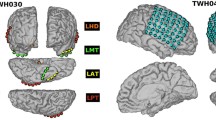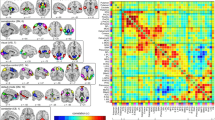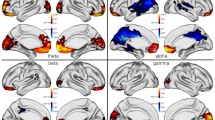Abstract
The default mode network (DMN) reflects spontaneous activity in the resting human brain. Previous studies examined the difference in static functional connectivity (sFC) of the DMN between eyes-closed (EC) and eyes-open (EO) using the resting-state functional magnetic resonance imaging (rs-fMRI) data. However, it remains unclear about the difference in dynamic FC (dFC) of the DMN between EC and EO. To this end, we acquired rs-fMRI data from 19 subjects in two different statues (EC and EO) and selected a seed region-of-interest (ROI) at the posterior cingulate cortex (PCC) to generate the sFC map. We identified the DMN consisting of ten clusters that were significantly correlated with the PCC. By using a sliding-window approach, we analyzed the dFC of the DMN. Then, the Newman’s modularity algorithm was applied to identify dFC states based on nodal total connectivity strength in each sliding-window. In addition, graph-theory based network analysis was applied to detect dynamic topological properties of the DMN. We identified three group-level dFC states (State1, 2 and 3) that reflects the strength of dFC within the DMN between EC and EO in different time. The following results were reached: (1) no significant difference in sFC between EC and EO, (2) dFC was lower in State2 but higher in State3 in EC than in EO, (3) lower clustering coefficient, local efficiency, and global efficiency, but higher characteristic path length in State2 in EC than in EO, and (4) lower nodal strength in the precuneus (PCUN), PCC, angular gyrus (ANG), middle temporal gyrus (MTG) and medial prefrontal cortex (MPFC) in State3 in EC. These results suggested different resting statuses, EC and EO, may induce different time-varying neural activity in the DMN.





Similar content being viewed by others
Abbreviations
- ANG:
-
Angular gyrus
- DMN:
-
Default mode network
- dFC:
-
Dynamic functional connectivity
- EC:
-
Eyes-closed
- EO:
-
Eyes-open
- FWE:
-
Family-wise error
- FWHM:
-
Full-width at half maximum
- LPC:
-
Lateral parietal cortex
- MPFC:
-
Medial prefrontal cortex
- MTG:
-
Middle temporal gyrus
- OFG:
-
Occipital fusiform gyrus
- PCC:
-
Posterior cingulate cortex
- PCUN:
-
Precuneus
- PHG:
-
Parahippocampal gyrus
- rs-fMRI:
-
Resting-state functional magnetic resonance imaging
- sFC:
-
Static functional connectivity
- SCA:
-
Seed-based connectivity analysis
- VF:
-
Visual fixation
References
Agcaoglu O, Wilson T, Wang YP, Stephen J, Calhoun VD (2019) Resting state connectivity differences in eyes open versus eyes closed conditions. Hum Brain Mapp 40(8):2488–2498
Allen EA, Damaraju E, Plis SM, Erhardt EB, Eichele T, Calhoun VD (2014) Tracking whole-brain connectivity dynamics in the resting state. Cereb Cortex 24(3):663–676
Andrews-Hanna JR, Snyder AZ, Vincent JL, Lustig C, Head D, Raichle ME, Buckner RL (2007) Disruption of large-scale brain systems in advanced aging. Neuron 56(5):924–935
Barber AD, Lindquist MA, DeRosse P, Karlsgodt KH (2018) Dynamic functional connectivity states reflecting psychotic-like experiences. Biol Psychiatry 3(5):443–453
Biswal B, Zerrin Yetkin F, Haughton VM, Hyde JS (1995) Functional connectivity in the motor cortex of resting human brain using echo-planar mri. Magn Reson Med 34(4):537–541
Boly M, Vanhaudenhuyse A, Tshibanda L, Bruno M, Boveroux P, Noirhomme Q, Schnakers C, Demertzi A, Ledoux D, Lambermont B (2008) Resting state connectivity integrity in the Default Network reflects the level of consciousness impairment in brain-injured patents. An fMRI study in brain death, coma, vegetative state, minimally conscious state and locked-in syndrome. In: Proceedings of 12th Annual Meeting of the Association for the Scientific Study of Consciousness, pp 19–22
Boyacioğlu R, Schulz J, Müller NCJ et al (2014) Whole brain, high resolution multiband spin-echo EPI fMRI at 7 T: a comparison with gradient-echo EPI using a color-word Stroop task. NeuroImage 97:142–150
Buckner RL, DiNicola LM (2019) The brain’s default network: updated anatomy, physiology and evolving insights. Nat Rev Neurosci 20(10):593–608
Calhoun VD, Potluru VK, Phlypo R, Silva RF, Pearlmutter BA, Caprihan A, Plis SM, Adalı T (2013) Independent component analysis for brain fMRI does indeed select for maximal independence. PLoS ONE 8(8):e73309
Calhoun VD, Miller R, Pearlson G, Adalı T (2014) The chronnectome: time-varying connectivity networks as the next frontier in fMRI data discovery. Neuron 84(2):262–274
Cauley SF, Polimeni JR, Bhat H, Wald LL, Setsompop K (2014) Interslice leakage artifact reduction technique for simultaneous multislice acquisitions. Magn Reson Med 72(1):93–102
Chai XJ, Ofen N, Gabrieli JD, Whitfield-Gabrieli S (2014) Development of deactivation of the default-mode network during episodic memory formation. NeuroImage 84:932–938
Chang C, Glover GH (2010) Time–frequency dynamics of resting-state brain connectivity measured with fMRI. NeuroImage 50(1):81–98
Christoff K, Gordon AM, Smallwood J, Smith R, Schooler JW (2009) Experience sampling during fMRI reveals default network and executive system contributions to mind wandering. Proc Natl Acad Sci 106(21):8719–8724
Cole DM, Smith SM, Beckmann CF (2010) Advances and pitfalls in the analysis and interpretation of resting-state FMRI data. Front Syst Neurosci 4:8
Cruse D, Chennu S, Chatelle C, Bekinschtein TA, Fernández-Espejo D, Pickard JD, Laureys S, Owen AM (2011) Bedside detection of awareness in the vegetative state: a cohort study. Lancet 378(9809):2088–2094
Daubechies I, Roussos E, Takerkart S, Benharrosh M, Golden C, D’ardenne K, Richter W, Cohen JD, Haxby J (2009) Independent component analysis for brain fMRI does not select for independence. Proc Natl Acad Sci 106(26):10415–10422
Du Y, Pearlson GD, Yu Q, He H, Lin D, Sui J, Wu L, Calhoun VD (2016) Interaction among subsystems within default mode network diminished in schizophrenia patients: a dynamic connectivity approach. Schizophr Res 170(1):55–65
Fox MD, Snyder AZ, Vincent JL, Corbetta M, Van Essen DC, Raichle ME (2005) The human brain is intrinsically organized into dynamic, anticorrelated functional networks. Proc Natl Acad Sci USA 102(27):9673–9678
Fox MD, Zhang D, Snyder AZ, Raichle ME (2009) The global signal and observed anticorrelated resting state brain networks. J Neurophysiol 101(6):3270–3283
Friston K (2002) Beyond phrenology: what can neuroimaging tell us about distributed circuitry? Annu Rev Neurosci 25(1):221–250
Gao W, Chen S, Biswal B, Lei X, Yuan J (2018) Temporal dynamics of spontaneous default-mode network activity mediate the association between reappraisal and depression. Soc Cogn Affect Neurosci 13(12):1235–1247
Gonzalez-Castillo J, Hoy CW, Handwerker DA, Robinson ME, Buchanan LC, Saad ZS, Bandettini PA (2015) Tracking ongoing cognition in individuals using brief, whole-brain functional connectivity patterns. Proc Natl Acad Sci USA 112(28):8762–8767
Gusnard DA, Akbudak E, Shulman GL, Raichle ME (2001) Medial prefrontal cortex and self-referential mental activity: relation to a default mode of brain function. Proc Natl Acad Sci USA 98(7):4259–4264
Hayes SM, Nadel L, Ryan L (2007) The effect of scene context on episodic object recognition: parahippocampal cortex mediates memory encoding and retrieval success. Hippocampus 17(9):873–889
He C, Chen Y, Jian T, Chen H, Guo X, Wang J, Wu L, Chen H, Duan X (2018) Dynamic functional connectivity analysis reveals decreased variability of the default-mode network in developing autistic brain. Autism Res 11(11):1479–1493
Hlinka J, Alexakis C, Diukova A, Liddle PF, Auer DP (2010) Slow EEG pattern predicts reduced intrinsic functional connectivity in the default mode network: an inter-subject analysis. NeuroImage 53(1):239–246
Holland D, Kuperman JM, Dale AM (2010) Efficient correction of inhomogeneous static magnetic field-induced distortion in Echo Planar Imaging. NeuroImage 50(1):175–183
Hutchison RM, Womelsdorf T, Allen EA, Bandettini PA, Calhoun VD, Corbetta M, Della Penna S, Duyn JH, Glover GH, Gonzalez-Castillo J (2013) Dynamic functional connectivity: promise, issues, and interpretations. NeuroImage 80:360–378
Jackson RL, Cloutman LL, Ralph MAL (2019) Exploring distinct default mode and semantic networks using a systematic ICA approach. Cortex 113:279–297
Jahanian H, Holdsworth S, Christen T, Wu H, Zhu K, Kerr AB, Middione MJ, Dougherty RF, Moseley M, Zaharchuk G (2019) Advantages of short repetition time resting-state functional MRI enabled by simultaneous multi-slice imaging. J Neurosci Methods 311:122–132
Jenkins AC (2019) Rethinking cognitive load: a default-mode network perspective. Trends Cogn Sci 23(7):531–533
Joel SE, Caffo BS, van Zijl PC, Pekar JJ (2011) On the relationship between seed-based and ICA‐based measures of functional connectivity. Magn Reson Med 66(3):644–657
Klugah-Brown B, Luo C, He H, Jiang S, Armah GK, Wu Y, Li J, Yin W, Yao D (2019) Altered dynamic functional network connectivity in frontal lobe epilepsy. Brain Topogr 32(3):394–404
Kozasa EH, Sato JR, Russell TA, Barreiros MA, Lacerda SS, Radvany J, Mello LE, Amaro E (2017) Differences in default mode network connectivity in meditators and non-meditators during an attention task. J Cogn Enhanc 1(2):228–234
Kucyi A, Davis KD (2014) Dynamic functional connectivity of the default mode network tracks daydreaming. NeuroImage 100:471–480
Lee Y-B, Yoo K, Roh JH, Moon W-J, Jeong Y (2019) Brain-state extraction algorithm based on the state transition (BEST): a dynamic functional brain network analysis in fMRI study. Brain Topogr 32(5):897–913
Liégeois R, Li J, Kong R et al (2019) Resting brain dynamics at different timescales capture distinct aspects of human behavior. Nat Commun 10(1):1–9
Lin P, Yang Y, Jovicich J, De Pisapia N, Wang X, Zuo CS, Levitt JJ (2016) Static and dynamic posterior cingulate cortex nodal topology of default mode network predicts attention task performance. Brain Imaging Behav 10(1):212–225
Lin P, Yang Y, Gao J, De Pisapia N, Ge S, Wang X, Zuo CS, Levitt JJ, Niu C (2017) Dynamic default mode network across different brain states. Sci Rep 7(1):1–13
Liu X, Li H, Luo F, Zhang L, Han R, Wang B (2015) Variation of the default mode network with altered alertness levels induced by propofol. Neuropsychiatric Dis Treat 11:2573
Mak LE, Minuzzi L, MacQueen G, Hall G, Kennedy SH, Milev R (2017) The default mode network in healthy individuals: a systematic review and meta-analysis. Brain Connect 7(1):25–33
Marusak HA, Calhoun VD, Brown S, Crespo LM, Sala-Hamrick K, Gotlib IH, Thomason ME (2017) Dynamic functional connectivity of neurocognitive networks in children. Hum Brain Mapp 38(1):97–108
Marx E, Stephan T, Nolte A, Deutschländer A, Seelos KC, Dieterich M, Brandt T (2003) Eye closure in darkness animates sensory systems. NeuroImage 19(3):924–934
Marx E, Deutschländer A, Stephan T, Dieterich M, Wiesmann M, Brandt T (2004) Eyes open and eyes closed as rest conditions: impact on brain activation patterns. NeuroImage 21(4):1818–1824
McNabb CB, Lindner M, Shen S, Burgess LG, Murayama K, Johnstone T (2020) Inter-slice leakage and intra-slice aliasing in simultaneous multi-slice echo-planar images. Brain Struct Funct 225(3):1153–1158
Meyer ML, Lieberman MD (2018) Why people are always thinking about themselves: medial prefrontal cortex activity during rest primes self-referential processing. J Cogn Neurosci 30(5):714–721
Milner B (2005) The medial temporal-lobe amnesic syndrome. Psychiatric Clin 28(3):599–611
Mingoia G, Wagner G, Langbein K, Maitra R, Smesny S, Dietzek M, Burmeister HP, Reichenbach JR, Schlösser RG, Gaser C (2012) Default mode network activity in schizophrenia studied at resting state using probabilistic ICA. Schizophr Res 138(2–3):143–149
Mitchell JP, Banaji MR, MacRae CN (2005) The link between social cognition and self-referential thought in the medial prefrontal cortex. J Cogn Neurosci 17(8):1306–1315
Moeller S, Yacoub E, Olman CA et al (2010) Multiband multislice GE-EPI at 7 tesla, with 16-fold acceleration using partial parallel imaging with application to high spatial and temporal whole-brain fMRI. Magn Reson Med 63(5):1144–1153
Muthulingam JA, Hansen TM, Drewes AM, Olesen SS, Frøkjær JB (2020) Disrupted functional connectivity of default mode and salience networks in chronic pancreatitis patients. Clin Neurophysiol 131(5):1021–1029
Newman ME (2006) Modularity and community structure in networks. Proc Natl Acad Sci USA 103(23):8577–8582
Patriat R, Molloy EK, Meier TB, Kirk GR, Nair VA, Meyerand ME, Prabhakaran V, Birn RM (2013) The effect of resting condition on resting-state fMRI reliability and consistency: a comparison between resting with eyes open, closed, and fixated. NeuroImage 78:463–473
Poerio GL, Sormaz M, Wang H-T, Margulies D, Jefferies E, Smallwood J (2017) The role of the default mode network in component processes underlying the wandering mind. Soc Cogn Affect Neurosci 12(7):1047–1062
Power JD, Lynch CJ, Silver BM et al (2019) Distinctions among real and apparent respiratory motions in human fMRI data. NeuroImage 201:116041
Qin P, Northoff G (2011) How is our self related to midline regions and the default-mode network? NeuroImage 57(3):1221–1233
Raichle ME (2015) The restless brain: how intrinsic activity organizes brain function. Philos Trans R Soc B 370(1668):20140172
Rashid B, Damaraju E, Pearlson GD, Calhoun VD (2014) Dynamic connectivity states estimated from resting fMRI Identify differences among Schizophrenia, bipolar disorder, and healthy control subjects. Front Hum Neurosci 8:897
Rubinov M, Sporns O (2010) Complex network measures of brain connectivity: uses and interpretations. NeuroImage 52(3):1059–1069
Rugg MD, Vilberg KL (2013) Brain networks underlying episodic memory retrieval. Curr Opin Neurobiol 23(2):255–260
Sämann PG, Wehrle R, Hoehn D, Spoormaker VI, Peters H, Tully C, Holsboer F, Czisch M (2011) Development of the brain’s default mode network from wakefulness to slow wave sleep. Cereb Cortex 21(9):2082–2093
Satpute AB, Lindquist KA (2019) The default mode network’s role in discrete emotion. Trends Cogn Sci 23(10):851–864
Sheline YI, Barch DM, Price JL, Rundle MM, Vaishnavi SN, Snyder AZ, Mintun MA, Wang S, Coalson RS, Raichle ME (2009) The default mode network and self-referential processes in depression. Proc Natl Acad Sci USA 106(6):1942–1947
Smitha K, Akhil Raja K, Arun K, Rajesh P, Thomas B, Kapilamoorthy T, Kesavadas C (2017) Resting state fMRI: a review on methods in resting state connectivity analysis and resting state networks. Neuroradiol J 30(4):305–317
Spaniol J, Davidson PS, Kim AS, Han H, Moscovitch M, Grady CL (2009) Event-related fMRI studies of episodic encoding and retrieval: meta-analyses using activation likelihood estimation. Neuropsychologia 47(8–9):1765–1779
Thompson WH, Fransson P (2015) The frequency dimension of fMRI dynamic connectivity: network connectivity, functional hubs and integration in the resting brain. NeuroImage 121:227–242
Todd N, Moeller S, Auerbach EJ, Yacoub E, Flandin G, Weiskopf N (2016) Evaluation of 2D multiband EPI imaging for high-resolution, whole-brain, task-based fMRI studies at 3T: sensitivity and slice leakage artifacts. NeuroImage 124:32–42
Tognoli E, Kelso JS (2014) The metastable brain. Neuron 81(1):35–48
Tononi G, Edelman GM, Sporns O (1998) Complexity and coherency: integrating information in the brain. Trends Cogn Sci 2(12):474–484
Van Dijk KR, Hedden T, Venkataraman A, Evans KC, Lazar SW, Buckner RL (2010) Intrinsic functional connectivity as a tool for human connectomics: theory, properties, and optimization. J Neurophysiol 103(1):297–321
Vanhaudenhuyse A, Noirhomme Q, Tshibanda LJ-F, Bruno M-A, Boveroux P, Schnakers C, Soddu A, Perlbarg V, Ledoux D, Brichant J-F (2009) Default network connectivity reflects the level of consciousness in non-communicative brain-damaged patients. Brain 133(1):161–171
Varikuti DP, Hoffstaedter F, Genon S, Schwender H, Reid AT, Eickhoff SB (2016) Resting-state test–retest reliability of a priori defined canonical networks over different preprocessing steps. Brain Struct Funct 222(3):1447–1468
Viviano RP, Raz N, Yuan P, Damoiseaux JS (2017) Associations between dynamic functional connectivity and age, metabolic risk, and cognitive performance. Neurobiol Aging 59:135–143
Wang C, Ong JL, Patanaik A, Zhou J, Chee MW (2016) Spontaneous eyelid closures link vigilance fluctuation with fMRI dynamic connectivity states. Proc Natl Acad Sci USA 113(34):9653–9658
Watanabe T, Kan S, Koike T, Misaki M, Konishi S, Miyauchi S, Miyahsita Y, Masuda N (2014) Network-dependent modulation of brain activity during sleep. NeuroImage 98:1–10
Wu L, Caprihan A, Bustillo J, Mayer A, Calhoun V (2018) An approach to directly link ICA and seed-based functional connectivity: application to schizophrenia. NeuroImage 179:448–470
Xiao F, Lu C, Zhao D, Zou Q, Xu L, Li J, Zhang J, Han F (2019) Independent component analysis and graph theoretical analysis in patients with narcolepsy. Neurosci Bull 35(4):743–755
Xu P, Huang R, Wang J, Van Dam NT, Xie T, Dong Z, Chen C, Gu R, Zang Y-F, He Y (2014) Different topological organization of human brain functional networks with eyes open versus eyes closed. NeuroImage 90:246–255
Yan C, Liu D, He Y, Zou Q, Zhu C, Zuo X, Long X, Zang Y (2009) Spontaneous brain activity in the default mode network is sensitive to different resting-state conditions with limited cognitive load. PLoS ONE 4(5):e5743
Yu Q, Erhardt EB, Sui J, Du Y, He H, Hjelm D, Cetin MS, Rachakonda S, Miller RL, Pearlson G (2015) Assessing dynamic brain graphs of time-varying connectivity in fMRI data: application to healthy controls and patients with schizophrenia. NeuroImage 107:345–355
Zhou X, Lei X (2018) Wandering minds with wandering brain networks. Neurosci Bull 34(6):1017–1028
Zhou Y, Milham MP, Lui YW, Miles L, Reaume J, Sodickson DK, Grossman RI, Ge Y (2012) Default-mode network disruption in mild traumatic brain injury. Radiology 265(3):882–892
Funding
This work was supported by funding from the National Natural Science Foundation of China (Grant numbers: 81871338, 81371535, and 81271548).
Author information
Authors and Affiliations
Corresponding author
Ethics declarations
Conflict of interest
The authors declare no competing financial interests.
Ethical Approval
The study protocol was approved by the Research Review Board of South China Normal University.
Informed Consent
Written informed consent was obtained from each subject before the study. Informed consent was obtained from all individual participants included in the study.
Additional information
Handling Editor: Micah M. Murray.
Publisher's Note
Springer Nature remains neutral with regard to jurisdictional claims in published maps and institutional affiliations.
Electronic supplementary material
Below is the link to the electronic supplementary material.
Rights and permissions
About this article
Cite this article
Liu, X., Wu, X., Zhong, M. et al. Dynamic Properties of Human Default Mode Network in Eyes-Closed and Eyes-Open. Brain Topogr 33, 720–732 (2020). https://doi.org/10.1007/s10548-020-00792-3
Received:
Accepted:
Published:
Issue Date:
DOI: https://doi.org/10.1007/s10548-020-00792-3




